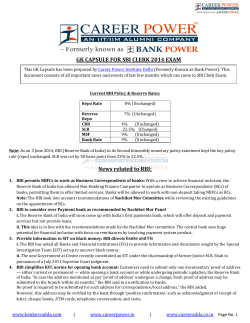
-Ç-C¢√®Ωç 10 -Çí∫Ææ’d 2014 Ñ-Ø√-úø’ £j«-ü¿®√-¶«-ü˛ 1
-Ç-C¢√®Ωç 10 -Çí∫Ææ’d 2014 Reserve Bank of India fter independence to India, RBI was nationalized on 1st January, 1949. ★ Banking Regulation Act 1949 empowered RBI and gave full-fledged functions of a central bank and as a banking and financial regulatory authority of India. By this RBI has authority to license and control banks, audit them, inspect, regulate and monitor. A Ñ-Ø√-úø’ £j«-ü¿®√-¶«-ü˛ Indian banking system has given a shape and structure by the formation of central bank in India, known as Reserve Bank of India (RBI). It was established in 1935 under RBI Act 1934 with a capital of 5 crores, divided into 100 shares of 5 lakhs each and was owned by government with limited functions. RRBs are supervised by..? RBI functions with certain objectives such as.... ★ To maintain monetary stability. ★ To maintain financial stability and ensure sound financial institutions. ★ To maintain stable payment systems. ★ To ensure credit allocation by the financial system. ★ To regulate the overall volume of money and credit in the economy. ★ To promote the development of financial markets. ★ To educate and convert the general public to use organized financial and banking sector. Some Important Functions of RBI: ★ Monitoring monetary policy by taking operate decision with the help of some direct and indirect tools like Cash Reserve Ratio (CRR), Statutory Liquidity Ratio (SLR), and Refinance facilities. These are direct tools. ★ A few indirect tools: RBI also uses some indirect tools like Liquidity Adjustment Facility (LAF), Repo / Reverse Repo Rate, Open Market Operations (OMO), Marginal Standing Facility (MSF), Bank Rate, and Market Stabilisation Scheme (MSS). ★ RBI prints currency notes with the help of its subsidiaries, 'The Security Printing and Minting Corporation of India Limited (SPMCIL)', 'The Bharatiya Reserve Bank Note Mudran Pvt. Ltd. (BRBNMPL)'. ★ On behalf of Government of India RBI mints rupee coin with the help subsidiaries, 'The Security Printing and Minting Corporation of India Limited (SPMCIL)' which are known as mints which comes under Coinage Act, 1906. ★ RBI acts as Banker and Debt Manager to Government. It maintain accounts and banking transactions of central government, it receive funds and make payments and transfer funds on behalf of government and also known as Banker to Banks. ★ RBI is the Regulator of the Indian Banking Services and System, it regulates through licensing banks, formulation of certain rules etc.,. It also known as Manager of foreign exchange and foreign reserves in India by appointing authorized dealers for exchanging foreign currency. Development of foreign currency reserves like Foreign Currency Assets (FCA), Special Drawing Rights (SDRs) and gold etc.,. The act that helps RBI to manage foreign exchange transactions is Foreign Exchange Management Act (FEMA) 1999. ★ RBI is Regulator and Supervisor of the Payment and Settlement Systems in India. All the clearing and settlements activities are done through different means and established different schemes and services like National Payments Corporation of India (NPCI), The Real Time Gross Settlement (RTGS), Electronic Funds Transfer (EFT), National Electronic Clearing Service (NECS), Electronic Clearing Service (ECS), Cheque Truncation System (CTS) etc. 1 Banking Knowledge 1. How many deputy governors does RBI have? a) One b) Two c) Three d) Four e) None 2. Who appoints the deputy governors of RBI? a) RBI Governor b) Union Government of India c) President of India d) Board of directors of RBI e) None 3. RBI is directly controlled by ....... a) Public b) All banks in India c) Central board of directors of RBI d) Union Government of India e) None of these 4. How many members will be there in RBI central board of directors? a) 15 b) 5 c) 21 d) 25 e) 272 5. RBI is formed under which act ....... a) RBI act 1935 b) RBI act 1934 c) Banking regulation act 1949 d) Indian Penal Code (IPC) 1947 e) None of these 6. Institutions, that are appearing in the second schedule of the RBI act 1934 are called as ....... a) Scheduled banks b) Only commercial banks c) Non Banking Financial Institutions (NBFC) d) Both a and c e) None of these 7. ....... acts as fundamentals to the nation's financial system. a) RBI b) Central Government c) Banks d) Central Bank e) None of these 8. Regional Rural Banks are supervised by ....... a) NABARD b) RBI c) State Government d) Central Government e) None of these 9. Identify the RBI Owned Subsidiaries ....... a) National Housing Bank (NHB). b) Bharatiya Reserve Bank Note Mudran Pvt Ltd (BRBNMPL). c) Deposit Insurance and Credit Guarantee Corporation (DICGC). d) National Bank for Agriculture and Rural Development (NABARD). e) All of these 10. RBI's quasi judicial authority for solving disputes between banks and their customer is known as ....... a) Banking codes and standards board of India. b)Customer services and dispute redressal cell. c) Banking ombudsman d) Judgments on disputes and services authority e) None of these 11. FEMA 1999 stands for ....... a) Financial Exchange Management Act 1999 b) Foreign Exchange Management Act 1999 c) Foreign Economy Management Act 1999 22. RBI's facility of repurchase of securities is d) Foreign External Management Act 1999 known as ....... e) None of these a) REPO Rate b) Reverse REPO rate 12. Primary activities of RBI are ....... c) Treasury bills d) Security rate a) Managing foreign exchanges b) Issuing currency notes e) None of these c) Maintaining financial stability 23. For efficient and effective payment and settlement system RBI must undertake followd) Regulating banking system in India ing activity ....... e) All of these a) Maintain of clearing houses at 13. Maintaining cash balance with various centers. RBI as a share of demand and time liabilities of bank is known b) Creation of currency holding as ....... chests in different areas. a) CRR b) SLR c) LAF c) Creation of the mechanism for d) MSF e) None of these electronic fund transfer. 14. Identify RBI Regulatory role from d) All the above e) None of these following....... 24. RBI's regulatory and supervisory S. Rudranand a) Licensing policy initiatives are aimed at ....... b) Monitoring governance a) Protection of the depositors' interests c) Regulating interest rates in specific areas b) Orderly development of banking services d) Prescribing capital requirements c) Conduct of banking operations e) All the above d) Liquidity and solvency of banks 15. What are the principles that guide RBI in e) All the above investing its foreign assets? 25. Name the publicity campaigns by RBI on a) Safety and liquidity security features of rupee currency note are b) Safety and returns display on poster at bank branches? c) Liquidity and returns a) Know Your Bank note d) Safety, liquidity and returns e) None b) Know Your Money 16. Larger value settlement of inter-bank transc) Know Your Currency (KYC) actions from financial markets is done d) Currency Note Education e) None through ....... 26. External commercial borrowings are such a) Real time gross settlement as ....... b) Internal payment and settlement a) Commercial-bank loan c) RBI payment system b) Buyers' credit d) National Electronic Funds Transfer c) Securitized instruments e) All the above d) Suppliers' credit e) All the above 17. National Bank for Agriculture and Rural 27. Who all cannot open account with RBI? Development is established for ....... a) Schedule banks b) Non-schedule banks a) Promoting mutual funds in the country c) General public b) Promoting and regulating housing d) Union Government of India finance in rural areas e) Both b and c c) Promoting rural and agricultural credit d) Regulating agriculture in rural areas Key e) None of these 11-b 16-a 21-b 26-e 6-a 1-d 18. Cash reserves consists of ....... 12-e 17-c 22-a 27-c. 7-c 2-b a) Cash 13-a 18-d 23-d 8-a 3-c b) Money market instruments 14-e 19-e 24-e 9-e 4-c c) Treasury bills 10-c 15-d 20-a 25-a 5-b d) All the above e) Only a and c 19. Main instruments available to Central Banks to control prime rates of leading banks ....... a) Repo rates b) Reverse repo rate c) Cash Reserve Ratio d) Statutory Liquidity Ratio e) All the above 20. Acceptance of deposits from the public for the purpose of lending and investment is the main activity of ....... a) Commercial banks b) Financial institutions ★ c) Primary dealers ★ d) Non banking financial companies e) All the above 21. Banks which are controlled by NABARD and State Government are? a) Urban cooperative banks ★ b) Rural cooperative banks c) Commercial banks d) Non-banking financial companies www.jnafau.ac.in e) None of these °‘@, °‘£«-î˝úŒ v§Úví¬¢˛’q £j«ü¿®√-¶«-ü˛-™E ï´-£æ«-®˝-™«™¸ ØÁv£æfi ÇJ\-õ„-éπa®˝ Åçú˛ °∂jØ˛ Ç®˝d q ߪ‚E-´-Jqöà Ȯí∫’u-©®˝/ §ƒ®˝d õ„jç °‘@, °‘£«-î˝úŒ éÓ®Ω’q™x v°æ¢Ë-¨»-EéÀ ØÓöÀ-°∂œ-Íé-≠æØ˛ Núø’-ü¿© îËÆœçC. éÓ®Ω’q©’: °‘£«-î˝úŒ, áç.á-°∂ˇ.á. N¶μ«-í¬©’: ÇJ\-õ„-éπa®˝, Å®ΩsØ˛ Åçú˛ Kï-†™¸ §ƒxEçí˚ Åçú˛ áEy-®√-Ø˛-¢Á’ç-ô™¸ úÕñ„jØ˛, Å°æx-®·ú˛ Ç®˝d Åçú˛ NV-´™¸ éπ´‚u-E-Íé-≠æØ˛, °®·ç-öÀçí˚, Ææ \©pa®˝, §∂Òö-ví∫°∂‘ Åçú˛ O’úÕߪ÷ éπ´‚u-E-Íé≠æØ˛ ¢Á·ü¿-™„j-†N. ü¿®Ω-ë«Ææ’h: ¢Á¶¸-ÂÆjö¸ †’ç* úˆØ˛-™ú˛ îËÆæ’-éӴa. *´J ûËC: 12 ÂÆ°dç-•®Ω’ ¢Á¶¸-ÂÆjö¸:
© Copyright 2025



















